Basic Britain: sliced ham
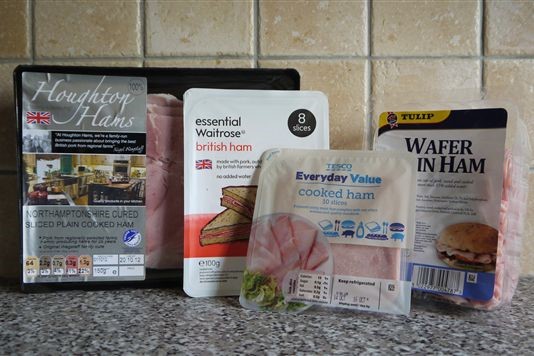
Packaged ham is a weekly staple for lunchtime sandwiches. But do you know where the meat comes from? And how do the brands differ to supermarket budget varieties? Laura Rowe finds out.
The contenders
Cooked, sliced ham should be one of the simplest things in the world to make. A cut of pork, some salt, and a stint in the oven and Bob’s your uncle. But as with many food stuffs nowadays there often can be more to ham than meets the eye. So do the brands make their ham in the same way as the budget alternatives? This time, I’ve taken a look at:
• Tesco Everyday Value Cooked Ham (10 slices – 61p/125g)
• Waitrose Essentials British Ham (8 slices – £1.69/100g)
• Houghton Hams Northamptonshire Cured Sliced Cooked Ham (3 large slices – £2.79/150g)
• Tulip Wafer Thin Ham (45 slices – £1.99/444g)
How is sliced ham made?
So, how is ham made commercially? Most hams are made using the hind leg and haunch of a pig. The pork is then combined with a wet cure, typically using a mix of salt and saltpetre (also found in gunpowder). The saltpetre might sound scary but is essential to mass-produced ham – it helps prevent lethal forms of food poisoning, keeps the pork a lovely rosy pink (without it, it would turn grey) and, of course, imparts flavour. It can be injected directly into the meat (for speed) or the meat can marinate in the brine for maximum flavour. It is then cooked and sliced, to create what you see in the packets. Watch this episode of Food Unwrapped for an insight and take a glance over the BMPA standards of production for more details. So how does one product manage to produce its ham for 61p and another for £2.79?
How do the production methods differ?
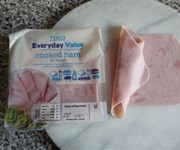 Tesco, which produces one type of cooked ham in its budget Everyday Value range (the rebranded ‘Tesco Value’), sources its pork from “within the EU” and no details were given of the conditions of living or breed of the animals. It creates its ham using “reformed ham” using “selected cuts of pork from the leg”. Reformed ham is often made from scraps of reformed ham, which is chopped or emulsified pieces of meat moulded together. These pieces can be taken from multiple pigs. Tesco admitted to using nitrite in its cure, as well as sodium ascorbate (a chemical form of Vitamin C) as “an antioxidant” and sodium and potassium triphosphates, which are used as “stabilisers”. The firm wouldn’t tell me if the cure is injected into the meat, or how long it is allowed to marinate but did say that it doesn’t use any “flavour sheets”, which can sometimes be wrapped around the ham for added flavour instead of a glaze like we might add at home. It does have added water, but doesn’t state how much. The pork content listed on the packet is 78%.
Tesco, which produces one type of cooked ham in its budget Everyday Value range (the rebranded ‘Tesco Value’), sources its pork from “within the EU” and no details were given of the conditions of living or breed of the animals. It creates its ham using “reformed ham” using “selected cuts of pork from the leg”. Reformed ham is often made from scraps of reformed ham, which is chopped or emulsified pieces of meat moulded together. These pieces can be taken from multiple pigs. Tesco admitted to using nitrite in its cure, as well as sodium ascorbate (a chemical form of Vitamin C) as “an antioxidant” and sodium and potassium triphosphates, which are used as “stabilisers”. The firm wouldn’t tell me if the cure is injected into the meat, or how long it is allowed to marinate but did say that it doesn’t use any “flavour sheets”, which can sometimes be wrapped around the ham for added flavour instead of a glaze like we might add at home. It does have added water, but doesn’t state how much. The pork content listed on the packet is 78%.
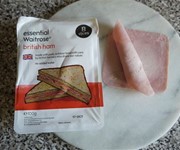 Waitrose, which has a surprising eight types of ham in its budget Essentials range, uses only British, “outdoor-bred” pork. It could even tell me the breeds – the sows are Duroc and Landrace and the boars are “specific Waitrose dedicated boars”. The pigs are born outside and then moved into “airy straw-filled barns at four weeks where they are free to express natural behaviour”. The supermarket explained that the muscles of the pork are butchered from the bone prior to the curing and cooking process. It too uses sodium nitrite, sodium ascorbate, as well as phosphates to stabilise and optimise the texture of the ham, which enables it to be sliced wafer thin “whilst maintaining slice integrity”. This brine is then injected into the meat and massaged for 24 hours. All of its flavours are natural, rather than produced by a flavour sheet, so the honey roast is coated in honey before roasting, and the smoke is achieved by real smoking over wood chippings. It also has “no added water” and 97% pork.
Waitrose, which has a surprising eight types of ham in its budget Essentials range, uses only British, “outdoor-bred” pork. It could even tell me the breeds – the sows are Duroc and Landrace and the boars are “specific Waitrose dedicated boars”. The pigs are born outside and then moved into “airy straw-filled barns at four weeks where they are free to express natural behaviour”. The supermarket explained that the muscles of the pork are butchered from the bone prior to the curing and cooking process. It too uses sodium nitrite, sodium ascorbate, as well as phosphates to stabilise and optimise the texture of the ham, which enables it to be sliced wafer thin “whilst maintaining slice integrity”. This brine is then injected into the meat and massaged for 24 hours. All of its flavours are natural, rather than produced by a flavour sheet, so the honey roast is coated in honey before roasting, and the smoke is achieved by real smoking over wood chippings. It also has “no added water” and 97% pork.
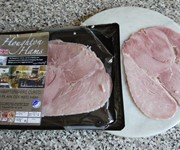 Houghton Hams, which are stocked in Co-ops across the Midlands, in some Waitrose stores and online at Ocado.com, has a range of organic and free-range hams. The Northamptonshire-cured variety I tested is RSPCA Welfare-Assured from local and regional farms in the UK. Its ham, unlike the budget varieties, isn’t formed or reformed but, surprisingly, it does inject its brine into the meat, which is then left to marinate for four days. It uses nitrite for the curing process although it says “levels have been substantially reduced over the last two years to meet EU Legislation”. It includes stabilisers and antioxidants “which stops the fat going rancid”. No flavour sheets are used nor is any water added.
Houghton Hams, which are stocked in Co-ops across the Midlands, in some Waitrose stores and online at Ocado.com, has a range of organic and free-range hams. The Northamptonshire-cured variety I tested is RSPCA Welfare-Assured from local and regional farms in the UK. Its ham, unlike the budget varieties, isn’t formed or reformed but, surprisingly, it does inject its brine into the meat, which is then left to marinate for four days. It uses nitrite for the curing process although it says “levels have been substantially reduced over the last two years to meet EU Legislation”. It includes stabilisers and antioxidants “which stops the fat going rancid”. No flavour sheets are used nor is any water added.
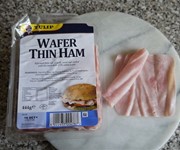 Tulip, which produces a range of ham products, declined to give any information for the feature and when pressed wouldn’t provide a reason why. I bought my pack from Tesco and gleaned this information from the packaging: the ham is made from reformed cuts of pork, cured and cooked with “not more than” 15% of water. The pork is sourced from the EU and America but cured, cooked and packed in the UK.
Tulip, which produces a range of ham products, declined to give any information for the feature and when pressed wouldn’t provide a reason why. I bought my pack from Tesco and gleaned this information from the packaging: the ham is made from reformed cuts of pork, cured and cooked with “not more than” 15% of water. The pork is sourced from the EU and America but cured, cooked and packed in the UK.
So how about the taste?
Tesco doesn’t look the most appealing – a mass of pale pink with rogue darker circles – but the texture is very smooth and the flavour delicate. It is not overly salty (indeed Tesco had the lowest sodium per 100g). Unoffensive but not particularly interesting.
Waitrose had a much more traditional ham texture, as you could see the grain of the meat. It was a lot firmer and you could actually taste the pork. Impressive – even if it was formed into an unnatural square.
Houghton Hams looked most like the ham you would buy from the butcher’s. The cut is a lot thicker than all the other hams and had a really distinctive flavour.
Tulip, which worked out the cheapest per slice, had the same pale pink marbling as Tesco and a completely smooth and uniform texture. It was very bland for my palate.
So, where do you get your ham for your lunchtime sarnie? And did you know what goes into making it? Would you buy budget, or do you always stick to premium or branded varieties? Let us know in the comments box below.
You might also like
Comments
Be the first to comment
Do you want to comment on this article? You need to be signed in for this feature